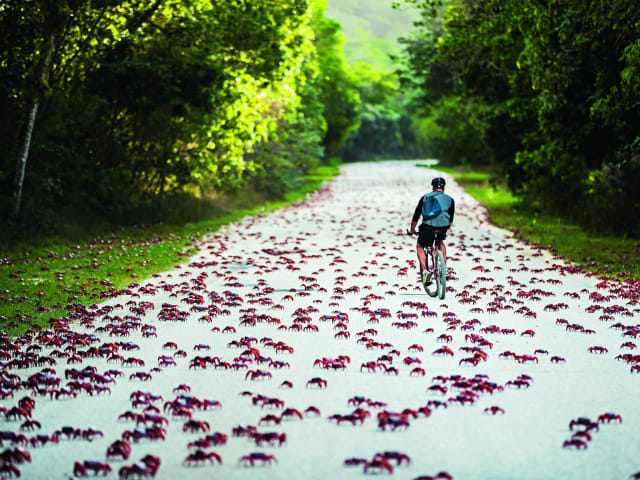Graphs
One small but inconvenient pandemic shift is that I’ve found it to be much harder to leave the house without forgetting something. I’m not leaving the house as much, so it’s a novelty to do the usual wallet / phone / keys check. I stepped out to run some errands the other day under an overcast sky. I didn’t get very far before my phone vibrated to tell me that I’d left my keys behind.
I picked up one of Apple’s new AirTags at Christmas and put it on my keychain. AirTags are a way of tracking keys, bags, wallets, phones – really anything you want to track. It’s an eerie technology that takes advantage of the wider network of ambient connections from unassuming bluetooth bystanders. You don’t opt-in to the network, the mere existence of your compatible phone in your pocket is enough.
Flying home from the UK after Christmas I popped one in my luggage and watched as my bags made their own way across the airport and ultimately the world. I imagined a baggage handler being the hub of thousands of Air Tag pings against the phone in her back pocket.
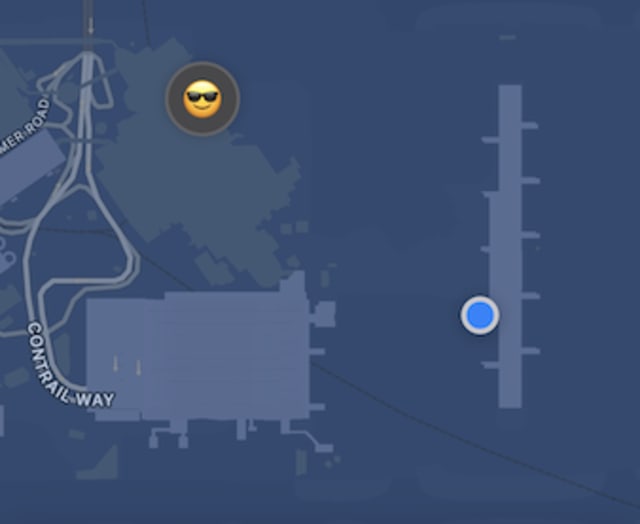
Amber Norsworthy of Mississippi was driving home when her phone pinged a notification she hadn’t heard before. Up flashed the message
“AirTag Found Moving With You”
This notification was noteworthy because Norsworthy didn’t own an AirTag. The alert was a safety feature from Apple to alert potential victims of stalking activity. Once home she searched the car and bags but didn’t find anything, but by then it was too late, the AirTag (wherever it was) had recorded and shared the location of her home and the route there. Horrifying.
Tracking devices aren’t new but having Apple’s vast network of devices to leverage has made the technology much more accessible. Instead of the device requiring the capability to phone home via satellites, it can piggy-back on other, more powerful devices, just passing by.
A company called Tile produced an early consumer model. I owned one of their original generation of trackers before Apple muscled into the space. My Tile tracker was a small plastic square with a hole for a keyring. Without the Apple network ecosystem the Tile mainly just told you where your own phone had seen the Tile last.
Unlike the Apple AirTag the Tile was single-use. Once the battery expired there was no way to replace it and it had to be shipped back to Tile for a discounted replacement.
Tile was in the news recently as they were bought by a Life360, a company with the reputation of selling precise location data of tens of millions of customers. Location data is big business, just this week Google was accused of deceiving users about location tracking in fresh lawsuits by three states in the US.
Small network, meet big network
The ubiquity of Apple devices has created a massive network, and it is this ecosystem that has made the AirTag so successful. But in a strange twist (that’s also convenient for the growth of Apple’s ubiquity), devices from other manufacturers won’t automatically notify their owners of suspicious AirTags.
With or without an Apple device, someone can still be targeted using more traditional tracking technology, it’s just that the AirTag is dramatically cheaper and therefore more accessible than those options.
Apple has released an Android app to allow detection of unauthorized AirTags traveling with you, but the number of people that will download these apps will likely be a lot smaller than those who have Apple devices with it on by default.
SealCam / Fishing Network
Back in October, a camera presumed lost for three years was found on the ocean floor in Nova Scotia. The footage it contained had an unlikely camera operator: a male grey seal. Ocean researchers use cameras in tandem with GPS monitoring and accelerometers to understand the migration, distribution, reproduction, and feeding patterns of seals and other sea creatures.
Watching the footage back is the closest you’ll get to being a seal. It’s like a video game where you swim around, forage and snap at passing fish, all from a seal’s-eye-view. For researchers, it unlocks insights that simply aren’t possible through plain observation. One fun fact learned is that grey seals will often dive down to the ocean floor and fall asleep where they’ll be rolled by the current until they wake. Without the camera and sensors to confirm this behavior the dive pattern was assumed to be a form of foraging.
Until this camera was found the footage was lost with no ability to track it. In a bid to make the recording and retrieval more resilient, researchers leverage Bluetooth technology (as in the AirTag) to keep tabs on these devices and reduce the cost of the analysis.
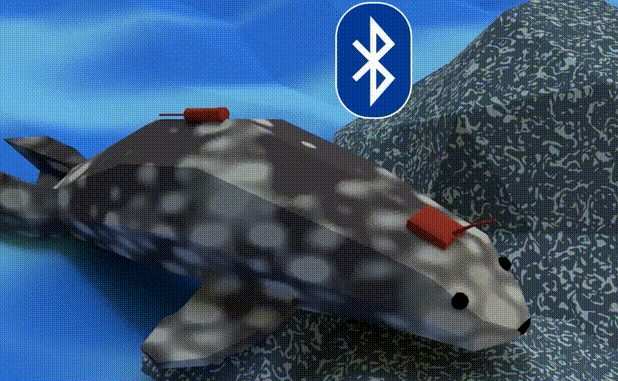
If you’ve ever watched a seal acrobatically glide through the water, you’ll know these static visualizations created from the tracking data don’t match the wonder of these beautiful creatures. Here’s one that could do with a #MarineMakeoverMonday.
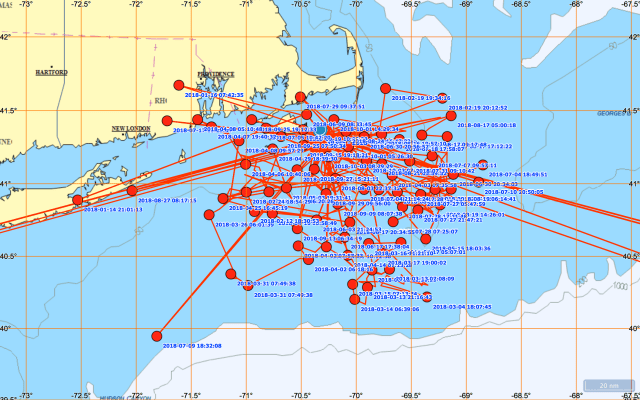
Sticking with seals, here’s a plot of the tracking pattern of five grey seals from July 2015 to May 2016 tagged on the Magdalen Islands in 2015.
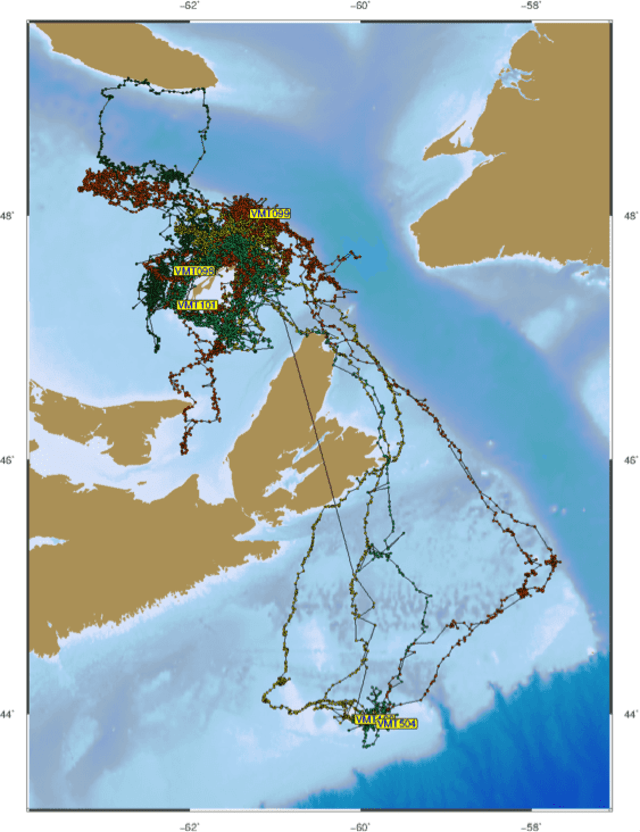
There’s a wider application for this sort of tracking in the ocean – how else is the U.S. military supposed to track their, I kid you not, militarized dolphins trained to protect nuclear power weapons?
Ocean Cleanup
Here in Victoria, BC, we’re close to the Salish Sea and I’ve taken more than a passing interest in the ships and boats that come and go from the shipyards nearby. With the cruise ships paused until this summer, each visiting vessel has been interesting to see towering over the marina. One such ship, the Zim Kingston, never made it much closer than 8km to the shore. And for good reason: it was on fire.
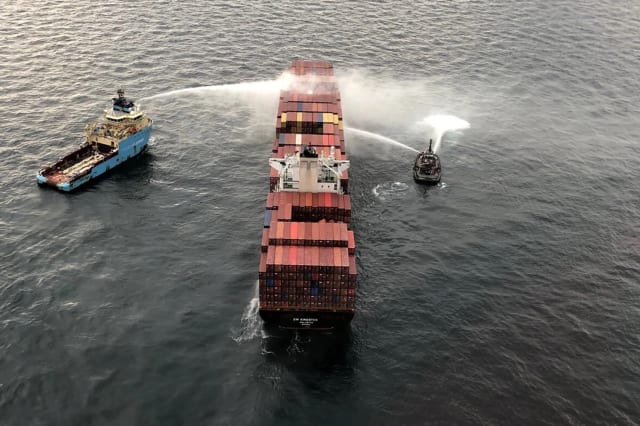
After losing over a hundred containers when traveling in rough seas a fire broke out on deck that blazed for several days. It was easy to spot the smoke and flames of the ship in person but VesselFinder offers live tracking and details of any vessel you can cast your eye on. (You may be familiar with that site after a surge in popularity during the Evergiven saga). Four months later, only four of the lost containers have been found.
A Rage of Plastics
A pair of ships have been docked near my apartment periodically over the past year with a distinctive pale blue base and cream top. They’re owned by nonprofit The Ocean Cleanup, and were fortuitously nearby and able to assist when the Zim Kingston was on fire.
On first pass I assumed an Ocean Cleanup was a pretty uncontroversial project – of course we want to clear the oceans of plastic, how noble for this charity to dedicate themselves to this cause. But there’s some suspicion that the environmental cost of the project isn’t enough to offset the amount of waste collected.
The Verge quotes Alexander Bond, senior curator in charge of the Bird Group at The Natural History Museum in the UK with the disappointing assessment:
if a gadget is going to clean up our plastic waste, then we can keep producing it. “It moves the proposed solution to ‘out there,’ where the trash is, rather than into our own lives, where the trash is being generated,”
A few months ago I featured a fantastic project that allowed you to follow a drop of rain to the ocean from anywhere in the US and it’s recently been updated to support rain drops anywhere on Earth. In a horrible contrast, a site from The Ocean Cleanup simulates how a single bit of plastic will ultimately make its way to the large patches of plastic floating in the ocean – like the Great Pacific Garbage Patch.
In “How Bad Are Plastics, Really?”, Environmental Sociologist Rebecca Altman argues that plastic waste is intrinsically twist-tied to the climate crisis
It can be hard to visualize the web that connects commonplace cups to the interlocking global crises of toxics, environmental injustice, and climate change, and even harder to locate where to intervene.
…
Should U.S. plastics production continue to grow as the industry projects, by 2030, it will eclipse the climate contributions of coal-fired power plants, […] Or, by another measure, the current growth trajectory means that by 2050, the industry’s emissions could eat up 15 percent, and potentially more, of the global carbon budget.
Unless it’s been incinerated and turned into an alternative form of toxic waste, the vast majority of plastic you’ve ever used still exists somewhere and will continue to exist for centuries. Think of the Tiles, containers and toothbrushes.
Links
- In 1917 it was possible to travel almost the entire way from Boston to Chicago by interurban electric trolleys
- Ostrich Eggshell Beads Reveal 50,000-Year-old Social Network Across Africa
- What if we could visualise the cost of attrition?
- Bad Ideas In Visualization
Nodes
Don’t look: crab in amber
Remember carcinization from edition #11? The tendency for species, given a sufficiently long timer period, to evolve into a crab? What about the undersea cable maps I’ve linked in different forms over the years?
I’ve resigned to the fact that over time this newsletter will just carcinize to pure networked crab content. Here are three very on-brand source/target crab links. Thanks to Rusty at Today in Crabs Tabs for perhaps all of these?
Brown crabs find underwater power cables ‘difficult to resist’
This Tiny Crustacean Trapped in Amber Tells a Different Story About Crab Evolution - Science
Includes this fantastic “crab tree of life” – the newly found 100+ million year old crab preserved in amber is crab F in the hit parade of top crabs.
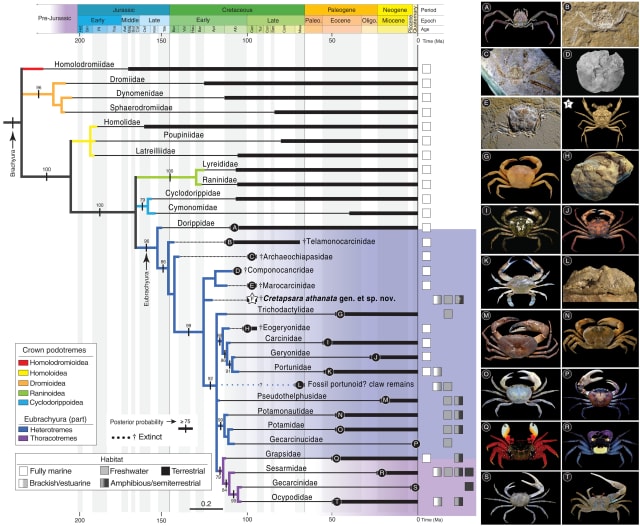
Back on the tracking theme for this week:
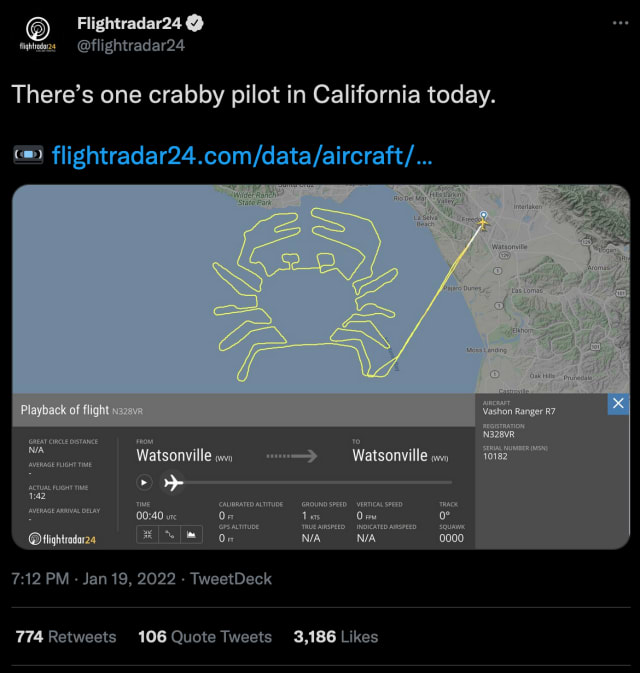
At a time when absolutely everyone is writing about NFTs, I’d like to just point you to a parallel exchange in the replies to that tweet:
What’s the point? Just wastage of fuel.
Because it looks cool in a flight tracker
Crabtion contest
One last thing. Rabbitholing crab content lead me to this “motivational poster” of a man just trying to get somewhere despite the thousands of crabs also trying to get somewhere.
In honor of their persistence I’d like to announce the first ever source/target caption contest – hit reply and let me know what you think. Best response gets a prize later this year.
